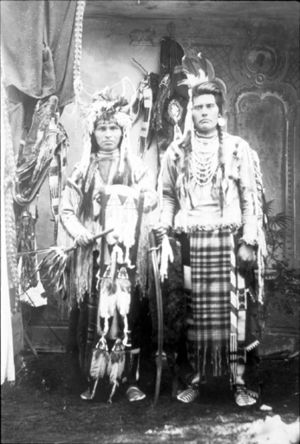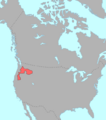Nez Perce language facts for kids
Quick facts for kids Nez Perce |
|
|---|---|
| Niimiipuutímt | |
| Native to | United States |
| Region | Idaho |
| Ethnicity | 610 Nez Perce people (2000 census) |
| Native speakers | 20 (2007) |
| Language family |
Plateau Penutian
|
Nez Perce, also called Nimipuutímt, is a language spoken by the Nez Perce people in the Northwestern United States. It belongs to the Sahaptian family, which is part of the larger Plateau Penutian group.
The name "Nez Perce" comes from a French phrase meaning "pierced nose." However, the Nez Perce people, who call themselves Nimiipuu (meaning "the people"), did not actually pierce their noses. This name might have been a mistake by the French, who may have confused them with other tribes who did pierce their noses.
Sadly, Nez Perce is a highly endangered language. This means very few people still speak it fluently. While the exact number changes, it's likely fewer than 100 speakers. The Nez Perce tribe is working hard to bring their language back through special programs. They want more people to learn and use it again.
Contents
Sounds of Nez Perce
The Nez Perce language has its own special sounds. It uses a system called vowel harmony, where vowels in a word change to match each other. This makes the words sound smooth. The language also has a complex way of using stress, which is how much emphasis you put on different parts of a word.
Consonant Sounds
Nez Perce has many consonant sounds, some of which might be new to English speakers. These include sounds made by pushing air out quickly, like a "pop" (called ejectives).
Vowel Sounds
Nez Perce has five main vowel sounds, and each can be spoken for a short or long time. This is called vowel length. The sounds are similar to the vowels in words like "ski," "boot," "boat," "cat," and "father."
Writing the Language
The Nez Perce language has its own alphabet, which helps people write down and learn the words. It includes some letters that look familiar and others that are unique to the language.
| a | a· | c | c’ | e | é· | h | i | í· | k | k’ | l | l’ | ł | ƛ | m | m’ | n | n’ | o |
| ó· | p | p’ | q | q’ | s | t | t’ | u | ú· | w | w’ | x | x̂ | y | y’ | ʔ |
How Nez Perce Grammar Works
One interesting thing about Nez Perce is that a single verb (an action word) can sometimes mean a whole sentence in English! This is called polysynthesis. It's like adding many small pieces of information to one word. These pieces, called affixes, tell you who is doing the action, who the action is being done to, when it happened (past, present), and if it's finished or still happening.
For example, a Nez Perce verb might include details like "I," "him," "fire," "fly," "grab," "straight through," and "go away," all in one word!
History of Nez Perce Grammar
An important person in studying Nez Perce grammar was Asa Bowen Smith. In the 1800s, he created a way to write the language down. He used an alphabet from Hawaiian missions and added new letters for Nez Perce sounds. He even wrote a book about the language's grammar in 1840. Later, other experts like Haruo Aoki also wrote important books and dictionaries about Nez Perce.
How Words Change (Case)
In Nez Perce, words change their endings to show their job in a sentence. This is called grammatical case. It's a bit like how in English we say "he" (when he's the one doing something) versus "him" (when something is done to him).
Nez Perce has a special system where the subject of a sentence (who is doing the action) and the object (who the action is done to) can have different endings. This means the order of words in a sentence can be very flexible. Unlike English, where "Dog bites man" means something different from "Man bites dog," Nez Perce uses word endings to make it clear who is doing what, no matter the order.
For example, if a grizzly bear is chasing someone, the word for "grizzly" would have a special ending to show it's the one doing the chasing. If people respect the grizzly, the word for "grizzly" would have a different ending to show it's the one being respected.
Learning Materials
If you're interested in learning more about Nez Perce, there are some helpful resources:
- Dictionaries: Books that list Nez Perce words and their meanings.
- Grammar Books: Books that explain how the language works and how to put sentences together.
- Texts and Stories: Collections of stories and other writings in Nez Perce, sometimes with translations.
- Audio Tapes: Recordings that help you hear how the language is spoken.
These materials are important for anyone wanting to study or help keep the Nez Perce language alive.
Images for kids





